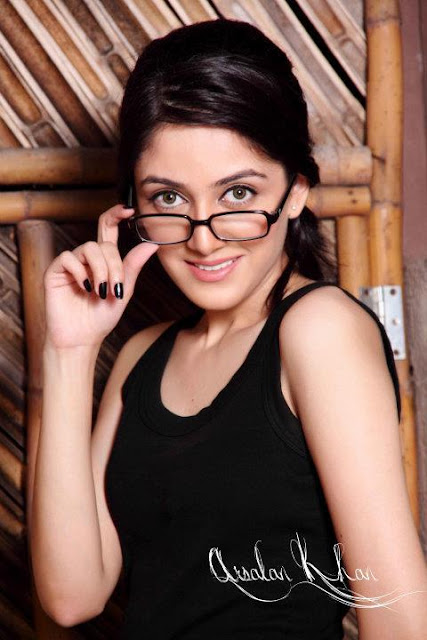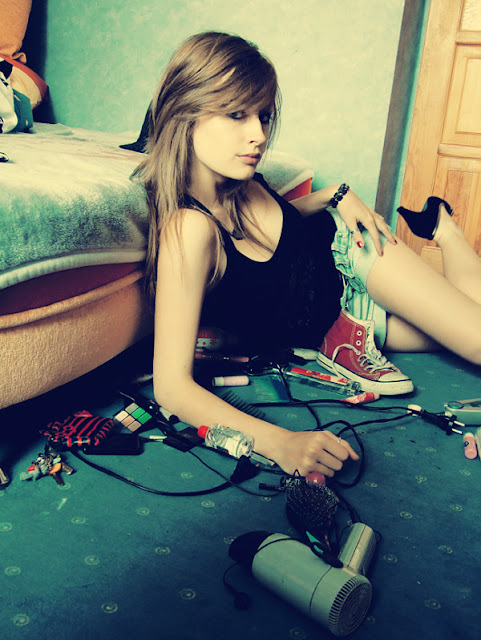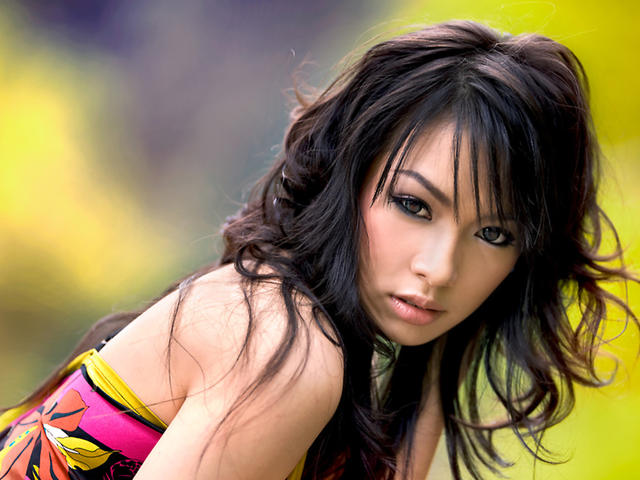With Andy Warhol, art and fashion merged. The famed painter of Campbell's soup cans, who began his career illustrating fashion magazines, would show up to black-tie events wearing yellow sunglasses, a tattered tuxedo jacket and paint-splattered pants. His Pop art influenced paper A-line "souper" dresses in the '60s, and designers have taken turns transposing his iconic works into clothes.
Though she was part of the original supermodel troupe — made famous by the now iconic Vogue magazine cover in January 1990 that featured her along with fellow models Naomi Campbell, Christy Turlington, Linda Evangelista and Tatjana Patitz — Crawford, with her distinctive beauty mark, stood out from the pack. Her big hair and curves would win her fans, but she somehow managed to keep one foot firmly planted in the high-fashion world, walking the runway for the likes of Dolce & Gabbana, Karl Lagerfeld for Chanel, and Versace.
At a time when many models made a name for themselves by looking heroin-chic, Crawford's bodacious-'80s-babe style won her lucrative endorsement deals with Revlon, which lasted for more than a decade, and Pepsi that made her the top-paid model by 2000 and a household name.
And with her rise to fame came a new image of what a supermodel should be. As fashion designer Michael Kors once said, "Cindy changed up the perception of the 'sexy American girl' from classic blue-eyed blonde to a more sultry brunette with brains, charm and professionalism to spare." These days, the American beauty is sharing her fashion flair with a furniture collection with Rooms to Go.
When Kate Moss launched her modeling career in the late 1980s, the wafer-thin girl from London didn't fit the mold of the superstars who came before her — tall, curvaceous and elegant women like Christy Turlington, Linda Evangelista and Naomi Campbell.
In a way, Moss's childlike "heroin chic" look, which was immortalized in a topless Calvin Klein advertisement when she was just 19, marked the end of the "supermodel era" and the renaissance of '90s grunge.
As famous for her antics as for her ad campaigns, Moss's personal life is often played out in the tabloids, with questions about her weight and alleged drug use casting a shadow over her otherwise successful career.
Discovered in her native Germany when she was 18, Heidi Klum's million-dollar smile and mile-long legs landed her on countless magazine covers, including Sports Illustrated's swimsuit issue in 1998 and 2006. In 2005, to the envy of women worldwide, she appeared in the Victoria's Secret fashion show less than two months after giving birth.
Need another reason to envy Klum? She also has serious business savvy. She serves as host and executive producer of Project Runway, an Emmy-winning reality show currently in its ninth season that has given a start to up-and-coming designers like Christian Siriano. Not too bad for a backup plan.
She's hardly the first First Lady to be recognized for her sartorial sense, but Michelle Obama is unparalleled in her influence on American fashion, from her arm-baring dresses and colorful cardigans to her mix of high-end and mass-retail designers.
From the beginning of her tenure as First Lady, Obama has been a champion of young designers, famously choosing a one-shoulder white dress by then little known designer Jason Wu for her Inaugural Ball.
She hasn't been afraid to defy tradition in the White House either, stirring controversy for picking a sleeveless black Michael Kors shift for her official portrait. These qualities have ingratiated her to fashion heavyweights, including Vogue editor in chief Anna Wintour, a Barack Obama supporter who spearheaded "Runway to Win," in February 2012, an initiative that sold designer clothing and accessories to benefit the president's re-election campaign.
Meanwhile, the First Lady's appearances in outfits by more affordable brands such as J. Crew and White House Black Market have caused those items to sell out within days, proving that Obama's influence is not just backed by love from the fashion industry, but empirical evidence, too.
When you're a fashion pioneer, you've earned the right to be a diva once in a while. At least that seems to be the motto of Naomi Campbell, who broke racial barriers as the first black model on the covers of French and British Vogue. She joined the clique of massively famous supermodels of the 1980s and '90s, dominating fashion magazines and runways in an industry accused to this day of favoring white models.
But Campbell didn't stand out for her runway walk alone. She became a tabloid fixture for her string of high-profile brawls with her employees. After pleading guilty to throwing her phone at her maid in 2007, she was ordered to serve five days of community service. But being the supermodel that she is, Campbell showed up in a different couture outfit every day, and the stint eventually became a feature in W magazine.
If there isn't a photo of Audrey Hepburn under the dictionary definition of gamine, there should be. The waifish actress charmed the audiences of movies like Roman Holiday, Sabrina and Breakfast at Tiffany's with her subtle portrayals of women in transformation, but it was her lithe frame and sprite-like carriage that earned her the devotion of couturiers like Hubert de Givenchy, who designed clot...hing she wore onscreen and off. Born in Brussels, she studied ballet in Amsterdam and never lost the lines of a dancer even as she grew older and moved from acting to a second career doing humanitarian work for UNICEF, proving that her beauty was far from skin deep.
There are performers, and then there are superstars. When Madonna burst onto the music scene in the 1980s, she was not only openly welcomed into that exclusive latter set but essentially redefined what it meant to be famous in America.
After struggling for years to make ends meet as a dancer, singer and model in New York City, Madonna finally caught her break when she was invited to perform "Holiday" on Dick Clark's American Bandstand in 1984.
Embraced early as a fashion idol — especially for the young generation — Madonna never ceased to amaze, nor has she ever lost control of her look or her career. From bridal gowns to cone bras and from sexy menswear to Asian inspirations, anything Madonna touched was emulated by her legions of fans around the world.
While her musical career has taken a backseat to family in recent years, she stepped up her role in fashion by teaming up with 14-year-old daughter Lourdes in 2010 to create Material Girl, a juniors fashion line available at Macy's. Now a new generation of girls who didn't get a chance to fawn over the Queen of Pop's every outfit can still mirror her style, if not her dance moves.
Lady Gaga is just as notorious for her outrageous style as she is for her pop hits. After all, Gaga, born Stefani Germanotta, has sported outfits made from plastic bubbles, Kermit the Frog dolls, and raw meat. And companies are catching on — Gaga has partnered with brands like Giorgio Armani on tour outfits, as well as Polaroid, and even pens a fashion column for V Magazine.
Ashley and Mary-Kate Olsen have managed to leverage child stardom into a legitimate career in fashion. Despite having no formal design education, the 25-year-old twins now preside over a veritable fashion empire and have transformed into style icons themselves.
The Olsens' first mass-market clothing label landed in Walmart stores when they were 12. Years later, Ashley's quest to find the perfect T-shirt led to the founding of The Row (named in an homage to London's Savile Row), which is a hit among professional women who desire quality pieces that are luxurious but not flashy. The sisters later launched Elizabeth and James, a hipper, bohemian line, followed by Olsenboye, their affordable collection at JCPenney, and Stylemint, which began as an online T-shirt venture.
Discovered at 14 in São Paulo, Brazil, Gisele Bündchen was dubbed "the world's most sought-after supermodel" by the time she was 20. Six years later, she became the world's highest-paid supermodel. She has made covers of fashion magazines and graced those of Newsweek and Vanity Fair.
Meanwhile, high-profile love affairs (boyfriend Leonardo DiCaprio, husband Tom Brady) have made her a household name.
Bündchen is the sun-kissed, bosomy antithesis of the waiflike heroin-chic models who dominated runways in the '90s. Editors want her on their pages, designers want her on their runways, businesses want her in their commercials, and people pay millions of dollars each year for products with her name on them.
Rock 'n' roll is no stranger to rebellious androgyny (the New York Dolls come to mind). But in the case of David Bowie — whether in Ziggy Stardust–era glam or as the drug-addled skeleton of his '70s funk period — it was always more than a defiant look. It was part of a much bigger creative identity.
When Iman was a student at Nairobi University, fashion photographer Peter Beard approached her to ask if she had had her picture taken before. At first she thought he meant ever. She was soon to leave Kenya, to make her first print appearance in Vogue, to become a familiar face on runways around the world and one of the first black supermodels. Iman officially retired from modeling in 1989, but she has continued to influence the industry.
She has been married to David Bowie for two decades and, in 2010, received the Fashion Icon award from the Council of Fashion Designers of America.
The glittering glove. The Thriller-era leather jacket. Those spit-shined penny loafers that gave him the otherworldly ability to glide across the stage.
Yes, it's no coincidence that we associate the different chapters of the King of Pop's career with the clothes he wore. But what's perhaps most impressive of all when it comes to Jackson's aesthetic is that it never once felt contrived. His wardrobe — though flamboyant — was never some grandiose political statement or performance-art afterthought. Like his music, his style reflected the inverse of an introverted artist wrought with complexity: flashy, singularly talented and larger than life.
It was a wardrobe, for lack of better words, fit for a king.
When a young Diana Spencer joined the British royal family in 1981, advisers selected her garments and dictated her style. But as Diana grew more confident in her role, she cast off their dictates and forged a path decidedly her own. Reflecting her personality, she made laidback look elegant, and transformed the traditional regal look into something altogether more inviting and modern. She loved color — from sparkling cabbage to crimson to orange — and materials from taffeta to lace. And while she popularized many of the over-the-top trends of the day — including bright floral prints, polka dots and voluminous sleeves — she did so with restraint. Diana wore the clothes, but they never wore Diana.
(From Yahoo! News)




























































